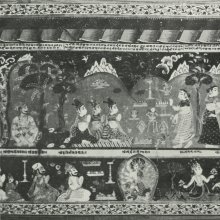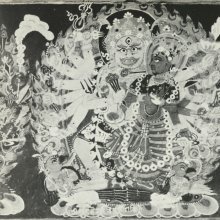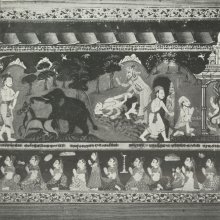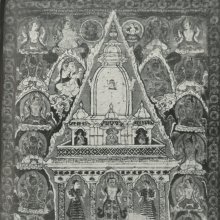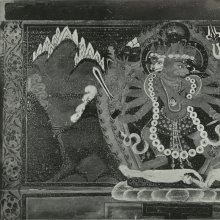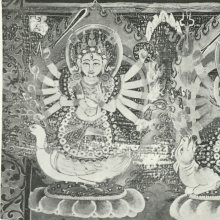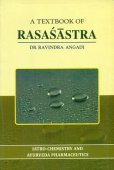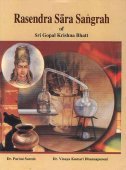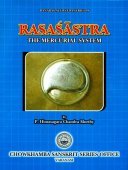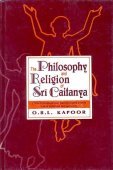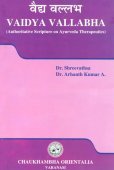Varanasi, Vārāṇasī, Varanashi, Vārāṇasi, Varaṇasī, Varāṇasī, Vāraṇasī, Vāraṇāsī: 34 definitions
Introduction:
Varanasi means something in Buddhism, Pali, Hinduism, Sanskrit, Jainism, Prakrit, the history of ancient India, Marathi, Hindi. If you want to know the exact meaning, history, etymology or English translation of this term then check out the descriptions on this page. Add your comment or reference to a book if you want to contribute to this summary article.
Images (photo gallery)
(+13 more images available)
In Hinduism
Shaivism (Shaiva philosophy)
Source: Wisdom Library: Kubjikāmata-tantra1) Vārāṇasī (वाराणसी):—The name for a ‘sacred site’ associated with the group of eight deities (mātṛ) born from Śaśinī, according to the Kubjikāmata-tantra. Śaśinī is the third of the Eight Mahāmātṛs, residing within the Mātṛcakra (third of the five cakras) and represents the moon.
2) Vārāṇasī (वाराणसी):—Sanskrit name for one of the twenty-four sacred sites of the Sūryamaṇḍala, the first maṇḍala of the Khecarīcakra, according to the kubjikāmata-tantra. The Khecarīcakra is the fifth and final cakra located just above the head. Each one of these holy sites (pītha) is presided over by a particular Khecarī (‘sky-goddess’). This Vārāṇasī-pītha is connected with the goddess Ūrdhvakeśī.
Source: Wisdom Library: Śaivism1) Vārāṇasi (वाराणसि) is a Sanskrit word referring to one of the sixty-eight places hosting a svāyambhuvaliṅga, one of the most sacred of liṅgas according to the Śaivāgamas. The presiding deity residing over the liṅga in this place (Vārāṇasi) is named Mahādeva. The list of sixty-eight svāyambhuvaliṅgas is found in the commentary of the Jirṇoddhāra-daśaka by Nigamajñānadeva. The word liṅga refers to a symbol used in the worship of Śiva and is used thoughout Śaiva literature, such as the sacred Āgamas.
2) Vārāṇasī (वाराणसी) is the name of a sacred site (pīṭha) to be assigned to the heart (hṛdaya) during the pīṭhavidhi (‘ritual of sacred sites’) according to the Tantrāloka chapter 29. This chapter of the Tantrāloka by Abhinavagupta expounds details regarding the Kula initiation ritual. Kula or Kaula is a specific tradition within Śaivism, closely related to Siddhānta and Śaktism. In the Jñānārṇava-tantra it is also mentioned as a pīṭha and is also called Kolvagiri.
Source: academia.edu: A Critical Study of the Vajraḍākamahātantrarāja (II) (shaivism)Vārāṇasī (वाराणसी) refers to one of the twenty-four sacred districts mentioned in the Kubjikāmatatantra (chapter 22). Vārāṇasī is presided over by the Goddess (Devī) named Śāṅkarī accompanied by the Field-protector (Kṣetrapāla) named Śāṅkara. Their weapon possibly corresponds to the gadā and their abode is the tāla-tree. A similar system appears in the 9th century Vajraḍākatantra (chapter 18).
Source: Brill: Śaivism and the Tantric Traditions1) Vārāṇasī (वाराणसी) or Avimukta is associated with Kālarāja, one of the “seven Bhairavas”, according to the Vārāṇasīmāhātmya 1.53-54.—Cf. The “eight Bhairavas” (originating from the blood of Andhaka when Śiva strikes him correspond with a set of eight Bhairavas), according to the Vāmanapurāṇa 44.23-38ff.
2) Vārāṇasī (वाराणसी) or Varuṇā is the name of a sacred region, according to the Tantrasadbhāva (verse 6.218): an important Trika Tantra and a major authority for Kashmiri Trika Śaivites.—Accordingly, “For those who know the Self, Prayāga should be understood as located in the [cakra of the] navel, Varuṇā [i.e. Vārāṇasī] in the heart region, Kolagiri in the throat, Bhīmanāda in the palate, Jayantī in the place of Bindu, Caritra in [the plexus] called Nāda, and Ekāmraka in [the plexus of] Śakti. The eighth, Koṭivarṣa, is likewise said to be in the Mouth of the Guru. These are the places I have declared to be present in the person internally”.
Note: This list of eight pīṭhas (e.g., Vārāṇasī) overlaps with the nine śmaśānas or pīṭhas of the Brahmayāmala’s principal maṇḍala (as outlined in chapter 3); however, it corresponds more precisely to the eight delineated in Brahmayāmala 87. Cf., also, Tantrasadbhāva 15.70:

Shaiva (शैव, śaiva) or Shaivism (śaivism) represents a tradition of Hinduism worshiping Shiva as the supreme being. Closely related to Shaktism, Shaiva literature includes a range of scriptures, including Tantras, while the root of this tradition may be traced back to the ancient Vedas.
Purana and Itihasa (epic history)
Source: archive.org: Puranic EncyclopediaVāraṇāsī (वारणासी).—(VĀRĀṆASĪ). Kāśī.
(Before reading the information given here refer to the details given about Kāśī under Kāśī and Divodāsa). The name Vāraṇāsī. Formerly this place was known as Prayāga. Later it got the name Vāraṇāsī and then Kāśī. The name Vāraṇāsī is originated from two rivers. Bhagavān Yogaśāyī who stays in Prayāga was born from a portion of Mahāviṣṇu. From the right leg of Yogaśāyī the river Varaṇā started and from his left leg the river Asī started. These two rivers are praised and worshipped all over the world. The temple of Yogaśāyī is situated in the place between these two rivers. As the place is situated between Varaṇā and Asī it is called Vāraṇāsi. (Vāmana Purāṇa, Chapter 3). Other information.
(i) Bhīṣma went to Kāśī and took Ambā, Ambikā and Ambālikā, the daughters of the King of Kāśī, to his kingdom by force. (Mahābhārata Ādi Parva, Chapter 102, Stanza 3).
(ii) Vāraṇāsī is a holy place of pilgrimage. By bathing in Kapilāhrada, a holy bath there, and worshipping Śaṅkara, one could obtain the fruits of performing the sacrifice Rājasūya. (Mahābhārata Vana Parva, Chapter 84, Stanza 78).
(iii) The middle part of Vāraṇāsī is called Avimukta. Those who forsake their lives at Avimukta will obtain heaven. (Mahābhārata Vana Parva, Chapter 84, Stanza 79).
(iv) Once Śrī Kṛṣṇa made Vāraṇāsī a prey to fire. (Mahābhārata Udyoga Parva, Chapter 48, Stanza 76).
(v) A very great scholar named Tulādhāra Vaiśya once lived in Vārāṇasī. (Mahābhārata Śānti Parva, Chapter 261, Stanza 41).
(vi) Once, in ancient days, Śiva imparted to the hermit Jaigīṣu at this place, the eight miraculous attainments such as aṇimā, garimā etc. (Mahābhārata Anuśāsana Parva, Chapter 18, Stanza 37).
(vii) Vāraṇāsī is equal to the capital city of Indra (Amarāvatī). (Mahābhārata Anuśāsana Parva, Chapter 30, Stanza 16).
(viii) In ancient days a hermit named Saṃvartta used to come here daily to worship Śiva. It was at this place that the emperor Marutta accepted the hermit Saṃvartta as his priest. (Mahābhārata Aśvamedha Parva, Chapters 6 and 7). (See full article at Story of Vāraṇāsī from the Puranic encyclopaedia by Vettam Mani)
Source: Cologne Digital Sanskrit Dictionaries: The Purana IndexVārāṇasī (वाराणसी).—Kāśī: sacred to Hari;1 fit for Śrāddha offering, and sacred to Lalitā;2 the capital of Divodāsa devastated by the Rākṣasa Kṣemaka, resulting in the change of capital to Gomatī. The abode of Śiva and Umā after their marriage, and hence the name Avimuktam Kṣetram;3 the goddess enshrined here is Viśālākṣī: a place of pilgrimage;4 capital of Rudraśṛeṇya of the Yadu race: city where Mārkaṇḍeya lived.5 Lord became Kṣetrapāla: the Yakṣa Harikeśa performed penance here;6 the place of Yogis and Siddhas: death here is release from rebirth;7 a siddha kṣetra where Śiva and His consort live all the three yugas and make Avimuktam gṛham in Kaliyuga;8 avatār of Lāngali at, in the 22nd dvāpara;9 cursed by Nikumbha to become deserted for 1,000 years;10 burnt down by Kṛṣṇa.11
- 1) Bhāgavata-purāṇa VII. 14. 31; X. 66. 40.
- 2) Brahmāṇḍa-purāṇa III. 13. 101; IV. 44. 93.
- 3) Ib. III. 67. 26-62.
- 4) Matsya-purāṇa 13. 26; 22. 7.
- 5) Ib. 43. 11; 103. 13.
- 6) Ib. 180. 1-5, 15 and 54.
- 7) Ib. 180. 72-79.
- 8) Vāyu-purāṇa 77. 93; 92. 27, 58-59; 99. 315.
- 9) Ib. 23. 198.
- 10) 92. 23-28.
- 11) Viṣṇu-purāṇa V. 34. 3, 39-41.
Vārāṇasī (वाराणसी) refers to the name of a Tīrtha (pilgrim’s destination) mentioned in the Mahābhārata (cf. II.82.61). Note: The Mahābhārata (mentioning Vārāṇasī) is a Sanskrit epic poem consisting of 100,000 ślokas (metrical verses) and is over 2000 years old.
Source: Shodhganga: The saurapurana - a critical studyVārāṇasī (वाराणसी) is the name of a Tīrtha (holy places) mentioned in the 10th century Saurapurāṇa: one of the various Upapurāṇas depicting Śaivism.—According to our Saurapurāṇa Vārāṇasī is the best of tīrthas and best of the kṣetras. It is the most favourite of Lord Śiva, where the Lord is said to have imparted the knowledge of mokṣa to all the creatures. Gaṅgā at Vārāṇasī is a famous tīrtha. [...] Vārāṇasī has remained a place dear to Śiva. It is supposed to be a place of mokṣa for all living creatures. There are many sacred places and innumerable liṅgas which are even unknown to Brahmā, so says the Saurapurāṇa.

The Purana (पुराण, purāṇas) refers to Sanskrit literature preserving ancient India’s vast cultural history, including historical legends, religious ceremonies, various arts and sciences. The eighteen mahapuranas total over 400,000 shlokas (metrical couplets) and date to at least several centuries BCE.
Shaktism (Shakta philosophy)
Source: Wisdom Library: ŚāktismVārāṇasī (वाराणसी) is the name of a Śāktapīṭha mentioned in the Kulārṇavatantra. The Kulārṇava-tantra is an important 11th century work for the Kaula school of Śāktism. It refers to eighteen such Śākta-pīṭhas (e.g. Vārāṇasī) which is defined as a sacred sanctuary of Devī located here on earth. According to legend, there are in total fifty-one such sanctuaries (pīṭha) on earth, created from the corresponding parts of Devī’s body,
Source: Google Books: ManthanabhairavatantramVārāṇasī (वाराणसी) (= Varṇā) is the name of a sacred site, and one of the places visited by the Goddess on her pilgrimage, according to Tantric texts such as the Kubjikāmata-tantra, the earliest popular and most authoritative Tantra of the Kubjikā cult.—Accordingly, “[The Goddess] went to Devīkoṭa, (arriving there) in a moment, and with a powerful look (āloka) (it became a sacred site. Then she went to) Aṭṭahāsa, (so called) because she laughed (there) loudly. (Then she went to) Kolāgiri, Ujjenī, Prayāga, Varṇā (i.e. Vārāṇasī), Viraja, Ekāmra and other (places) and (then on to) another universe”.

Shakta (शाक्त, śākta) or Shaktism (śāktism) represents a tradition of Hinduism where the Goddess (Devi) is revered and worshipped. Shakta literature includes a range of scriptures, including various Agamas and Tantras, although its roots may be traced back to the Vedas.
Kavya (poetry)
Source: Wisdom Library: KathāsaritsāgaraVārāṇasī (वाराणसी) is the name of an ancient city, according to the first story of the Vetālapañcaviṃśati in theKathāsaritsāgara, chapter 75. Accordingly, “... there is a city named Vārāṇasī, which is the dwelling-place of Śiva, inhabited by holy beings, and thus resembles the plateau of Mount Kailāsa. The River Ganges, ever full of water, flows near it, and appears as if it were the necklace ever resting on its neck”.
The story of Vārāṇasī is mentioned in the Vetālapañcaviṃśati (twenty-five tales of a vetāla) which is embedded in the twelfth book of the Kathāsaritsāgara (‘ocean of streams of story’). The main book is a famous Sanskrit epic detailing the exploits of prince Naravāhanadatta in his quest to become the emperor of the vidyādharas (celestial beings). The Kathā-sarit-sāgara is is explained to be an adaptation of Guṇāḍhya’s Bṛhatkathā which consisted of 100,000 verses and in turn forms part of an even larger work containing 700,000 verses.
Source: Shodhganga: The Kavyamimamsa of Rajasekhara
Vārāṇasī (वाराणसी) is the name a locality mentioned in Rājaśekhara’s 10th-century Kāvyamīmāṃsā.—Benaras, situated in state of Uttara-Pradesa.

Kavya (काव्य, kavya) refers to Sanskrit poetry, a popular ancient Indian tradition of literature. There have been many Sanskrit poets over the ages, hailing from ancient India and beyond. This topic includes mahakavya, or ‘epic poetry’ and natya, or ‘dramatic poetry’.
Nirukta (Sanskrit etymology)
Source: Shodhganga: The saurapurana - a critical study (nirukta)Vārāṇasī (वाराणसी) is derived from the names of two rivers—Varaṇā and Asi which form the southern and northen boundaries of the modern city of Benares.
Nirukta (निरुक्त) or “etymology” refers to the linguistic analysis of the Sanskrit language. This branch studies the interpretation of common and ancient words and explains them in their proper context. Nirukta is one of the six additional sciences (vedanga) to be studied along with the Vedas.
General definition (in Hinduism)
Source: Wisdom Library: HinduismVārāṇasī (वाराणसी).–One of the oldest and most famous places of pilgrimage in India; also known as Kāśī and Benares.
In Buddhism
Mahayana (major branch of Buddhism)
Source: Wisdom Library: Maha Prajnaparamita SastraVārāṇasī (वाराणसी) or Kāśi, on the central Ganges, the actual Benares. – It was at Benares in the Deer Park that the Buddha preached his first sermon, the Dharmacakrapravartanasūtra. He returned there several times afterwards (cf. Vinaya, I, p. 189, 216, 289; Saṃyutta, I, p. 105; V, p. 406; Aṅguttara, I, p. 110, 279; III, p. 392, 300). There he converted Yasa and many outstanding people (Vinaya, I, p. 15).
Source: archive.org: Bulletin of the French School of the Far East (volume 5)Vārāṇasī (वाराणसी) (in Chinese: Po-lo-nai) is identified with Benares and refers to one of the fifty-five kingdoms enumerated in chapter 17 of the Candragarbha: the 55th section of the Mahāsaṃnipāta-sūtra, a large compilation of Sūtras (texts) in Mahāyāna Buddhism partly available in Sanskrit, Tibetan and Chinese.—In the Candragarbhasūtra, the Bhagavat invites all classes of Gods and Deities to protect the Law [dharma?] and the faithful in their respective districts.—In Benares (Vārāṇasī), the following deities are appointed (among others): The Gandharva Sukeśin; the Yakṣa Anila; the Asura Sucitra; the Nāgarāja Takṣaka; the Devī (Goddess) Mahākālī.

Mahayana (महायान, mahāyāna) is a major branch of Buddhism focusing on the path of a Bodhisattva (spiritual aspirants/ enlightened beings). Extant literature is vast and primarely composed in the Sanskrit language. There are many sūtras of which some of the earliest are the various Prajñāpāramitā sūtras.
General definition (in Buddhism)
Source: Wisdom Library: BuddhismVaranasi:—The capitol of Kashi, one of the states of ancient India. Shakyamuni often preached in Varanasi.
In Jainism
General definition (in Jainism)
Source: archive.org: Sum Jaina Canonical Sutras (vividhatirthakalpa)Vārāṇasī (वाराणसी) is a town in Kāśī, watered by the Ganges. Two rivers, Varuṇā (Varṇā) and Asi, join the Ganges here; hence it is named Vārāṇasī. Also known as Vārāṇasīnagarī. Here were born two Brahmin brothers Jayaghoṣa and Vijayaghoṣa, who were versed in the four Vedas. They took to asceticism and attained salvation. Here lived an old merchant named Bhadrasena whose wife was Nandā and daughter, Nandaśrī. Nandaśrī retired from the world and received initiation. Two ascetics, Dharmaghoṣa and Dharmayaśa, spent the nights here during the rains.
Vārāṇasī is divided into four parts:—
- Deva-vārāṇasī.—Here is the temple of Viśvanātha wherein are to be seen twenty-four Jinapaṭṭas.
- Rājadhānī-vārāṇasī.—Here live the Yavanas now.
- Madana-vārāṇasī,
- Vijaya-vārāṇasī.
1) Vārāṇasī (वाराणसी) is the birth-place of Supārśva and Pārśva, the seventh and twenty-third Tīrthaṅkaras, according to chapter 1.6 [ādīśvara-caritra] of Hemacandra’s 11th century Triṣaṣṭiśalākāpuruṣacaritra: an ancient Sanskrit epic poem narrating the history and legends of sixty-three illustrious persons in Jainism.
2) Vārāṇasī (वाराणसी) is also the birth-place of Datta: one of the nine black Vāsudevas, according to the same chapter.
3) Vārāṇasī (वाराणसी) is the name of a city associated with Kāśi, which refers to one of the 25½ countries of the Kṣetrāryas, situated in the “middle world” (madhyaloka), according to chapter 2.3.—Accordingly, “In these 35 zones on this side of Mānuṣottara and in the Antaradvīpas, men arise by birth; [...]. From the division into Āryas and Mlecchas they are two-fold. The Āryas have sub-divisions [e.g., kṣetra (country)]. [...] The kṣetrāryas are born in the 15 Karmabhumis. Here in Bharata they have 25½ places of origin (e.g., Kāśi), distinguishable by cities (e.g., Vārāṇasī) in which the birth of Tīrthakṛts, Cakrabhṛts, Kṛṣṇas, and Balas takes place”.
Source: HereNow4u: Lord Śrī MahāvīraVārāṇasī (वाराणसी) is the name of a village visited by Mahāvīra during his eleventh year of spiritual-exertion.—Moving from Vraja village to Ālambhiyā, Śvetāmbikā, Sāvatthī, Kauśāmbī, Rājagṛha, Vārāṇasī, Mithilā, etc, the Lord arrived at Vaiśālī. Outside the city at the Baladeva temple in the Samara garden, accepting four-months fast, he became meditative and completed the rainy season halt there.
Vārāṇasī was also visited by Mahāvīra during his 6th Year as Kevalī.—Completing his monsoon stay at Vāṇijyagrāma the Lord proceeded to Vārāṇasī and stayed at ‘Koṣṭhaka-caitya’. There he gave a sermon to the people present, inspired by which the father of Cullinī, his wife Śyāmā and Surādeva and his wife Dhanyā became votaries.

Jainism is an Indian religion of Dharma whose doctrine revolves around harmlessness (ahimsa) towards every living being. The two major branches (Digambara and Svetambara) of Jainism stimulate self-control (or, shramana, ‘self-reliance’) and spiritual development through a path of peace for the soul to progess to the ultimate goal.
India history and geography
Source: What is India: Inscriptions of the ŚilāhārasVārāṇasī is the name of a village mentioned in the “Panhāle plates of Vikramāditya”. Accordingly, “who lives at the holy (town of) Vārāṇasī and has his body sanctified by seeing, bathing in and drinking (the water of) the Gaṅgā, for the purpose of the observance of the six (religious) duties, for the performance of bali, caru, vaiśvadeva, agnihotra and so forth”.
These copper plates (mentioning Vārāṇasī) were found at Panhāle in the Dāpolī-tālukā of the Ratnāgiri District. It records a grant made by Aparāditya for the spiritual welfare of his son, the prince (Kumāra) Vikramāditya. It was made by Aparāditya on the occasion of a lunar eclipse, on Monday, the 15th tithi of the bright fortnight of Āśvina in the expired Śaka year 1061.
Source: Knowledge Traditions & Practices of India: Architecture (1): Early and Classical Architecture (h)Vārāṇasī (Benares) is an archaeologically important site dating to the Ganges civilization (1000 BCE).—Nearly a millennium after the Indus civilization had collapsed, the Ganges civilization arose in the first millennium BCE. Among the first cities were, for example, Kanyakubja in today’s Uttar Pradesh.
Source: OpenEdition books: Vividhatīrthakalpaḥ (History)Vārāṇasī (वाराणसी) is the name of an ancient locality, associated with a pilgrimage route, as is mentioned in the Vividhatīrthakalpa by Jinaprabhasūri (13th century A.D.): an ancient text devoted to various Jaina holy places (tīrthas).

The history of India traces the identification of countries, villages, towns and other regions of India, as well as mythology, zoology, royal dynasties, rulers, tribes, local festivities and traditions and regional languages. Ancient India enjoyed religious freedom and encourages the path of Dharma, a concept common to Buddhism, Hinduism, and Jainism.
Languages of India and abroad
Marathi-English dictionary
Source: DDSA: The Molesworth Marathi and English Dictionaryvārāṇasī (वाराणसी).—f S (varaṇā & asī Names of two rivulets running by the city, the one on the north, the other on the south.) A name for Benares.
Source: DDSA: The Aryabhusan school dictionary, Marathi-Englishvārāṇasī (वाराणसी).—f A name for Benares.
Marathi is an Indo-European language having over 70 million native speakers people in (predominantly) Maharashtra India. Marathi, like many other Indo-Aryan languages, evolved from early forms of Prakrit, which itself is a subset of Sanskrit, one of the most ancient languages of the world.
Sanskrit dictionary
Source: DDSA: The practical Sanskrit-English dictionaryVaraṇasī (वरणसी).—More usually written वराणसी (varāṇasī) q. v.
--- OR ---
Varāṇasī (वराणसी).—See वाराणसी (vārāṇasī).
--- OR ---
Vāraṇasī (वारणसी).—See वाराणसी (vārāṇasī).
--- OR ---
Vārāṇasī (वाराणसी).—The holy city of Benares; कदा वाराणस्याममरतटिनीरोधसि वसन् (kadā vārāṇasyāmamarataṭinīrodhasi vasan) Bh.
Source: Cologne Digital Sanskrit Dictionaries: Shabda-Sagara Sanskrit-English DictionaryVaraṇasī (वरणसी).—f. (-sī) The city Benares, more usually vārāṇasī. E. varaṇā a rivulet as above, and asi another rivulet, running on the south of the city; deriv. irr.
--- OR ---
Varāṇasī (वराणसी).—f. (-sī) Benares. E. vara best, anas water, ṅīp aff., i. e. the Ganges, on whose bank the city is situated; also vārāṇasī and varaṇasī .
--- OR ---
Vārāṇasī (वाराणसी).—f. (-sī) The holy city Benares. E. vara best, anas water, affs. aṇ and ṅīṣ i. e. the Ganges on which it stands; also varāṇasī .
Source: Cologne Digital Sanskrit Dictionaries: Benfey Sanskrit-English DictionaryVārāṇasī (वाराणसी).—f. The city Benares, [Lassen, Anthologia Sanskritica.] 5, 20.
Source: Cologne Digital Sanskrit Dictionaries: Cappeller Sanskrit-English DictionaryVārāṇasī (वाराणसी).—[feminine] [Name] of a city (Benares).
Source: Cologne Digital Sanskrit Dictionaries: Monier-Williams Sanskrit-English Dictionary1) Varaṇasī (वरणसी):—[from vara] ([cf. Lexicographers, esp. such as amarasiṃha, halāyudha, hemacandra, etc.]) ([Demetrius Galanos’s Lexiko: sanskritikes, anglikes, hellenikes]) f. Benares (more usually varānasī and vārāṇasī, qq.vv.)
2) Varaṇāśī (वरणाशी):—[from vara] ([Demetrius Galanos’s Lexiko: sanskritikes, anglikes, hellenikes]) f. Benares (more usually varānasī and vārāṇasī, qq.vv.)
3) Varāṇasī (वराणसी):—[from varāṇasa > vara] f. Name of a river, [Mahābhārata]
4) [v.s. ...] the city of Benares (more usually written vārāṇasī cf. varaṇasī; two small rivers, the Varaṇā and Asī are said to join or give rise to the name See, [Religious Thought and Life in India 434]).
5) Vāraṇasī (वारणसी):—f. = vārāṇasī below.
6) Vārāṇasī (वाराणसी):—f. the city Benares (more properly written Banāras; [according to] to [Jābāla-upaniṣad] so called after the names of two rivers, varaṇā and asi, or asī; also written vāṇārasī q.v., varāṇasī or vāraṇasī), [Mahābhārata; Kāvya literature] etc.
7) cf. [Religious Thought and Life in India 434.]
Source: Cologne Digital Sanskrit Dictionaries: Yates Sanskrit-English Dictionary1) Varaṇasī (वरणसी):—(sī) 3. f. The city Benares.
2) Varāṇasī (वराणसी):—(sī) 3. f. Benares.
3) Vārāṇasī (वाराणसी):—(sī) 3. f. Benares.
Source: DDSA: Paia-sadda-mahannavo; a comprehensive Prakrit Hindi dictionary (S)Vārāṇasī (वाराणसी) in the Sanskrit language is related to the Prakrit word: Vāṇārasī.
[Sanskrit to German]
Sanskrit, also spelled संस्कृतम् (saṃskṛtam), is an ancient language of India commonly seen as the grandmother of the Indo-European language family (even English!). Closely allied with Prakrit and Pali, Sanskrit is more exhaustive in both grammar and terms and has the most extensive collection of literature in the world, greatly surpassing its sister-languages Greek and Latin.
Hindi dictionary
Source: DDSA: A practical Hindi-English dictionaryVārāṇasī (वाराणसी):—(nf) the holy city of Benares; ~[seya] belonging to or related, with [vārāṇasī].
...
Kannada-English dictionary
Source: Alar: Kannada-English corpusVāraṇaśi (ವಾರಣಶಿ):—[noun] = ವಾರಣಾಸಿ [varanasi].
--- OR ---
Vāraṇāsi (ವಾರಣಾಸಿ):—[noun] a city in Uttar Pradesh, in North Eastern part of India, held by Hindus as a most holy city; Kāśi; Benāras.
--- OR ---
Vārāṇasi (ವಾರಾಣಸಿ):—[noun] = ವಾರಣಾಸಿ [varanasi].
Kannada is a Dravidian language (as opposed to the Indo-European language family) mainly spoken in the southwestern region of India.
See also (Relevant definitions)
Starts with: Varanaci, Varanashikshe, Varanasidarpana, Varanasikara, Varanasimahatmya, Varanasipaddhati, Varanasiputra, Varanasishvara, Varanasiya.
Ends with: Katakavaranasi, Nirvaranasi, Varanaci.
Full-text (+519): Nirvaranasi, Kashi, Varanaci, Vanarasi, Varanaseya, Katakavaranasi, Vikramacanda, Avimukta, Shivapuri, Avimuktakshetra, Kasheya, Gamgasamaradhane, Varanasidarpana, Rajadhani, Varanasimahatmya, Trilocana, Sarasaraviveka, Vyakaranadipika, Udakabhrama, Pradipavivarana.
Relevant text
Search found 140 books and stories containing Varanasi, Vārāṇasī, Varanashi, Vārāṇasi, Varaṇasī, Varāṇasī, Vāraṇasī, Vāraṇāsī, Varaṇāśī, Varaṇasi, Vāraṇaśi, Vāraṇāsi; (plurals include: Varanasis, Vārāṇasīs, Varanashis, Vārāṇasis, Varaṇasīs, Varāṇasīs, Vāraṇasīs, Vāraṇāsīs, Varaṇāśīs, Varaṇasis, Vāraṇaśis, Vāraṇāsis). You can also click to the full overview containing English textual excerpts. Below are direct links for the most relevant articles:
Puranic encyclopaedia (by Vettam Mani)
Chaitanya Bhagavata (by Bhumipati Dāsa)
Verse 3.2.330-333 < [Chapter 2 - Description of the Lord’s Travel Through Bhuvaneśvara and Other Placesto Jagannātha Purī]
Verse 1.14.149 < [Chapter 14 - The Lord’s Travel to East Bengal and the Disappearance of Lakṣmīpriyā]
Verse 2.23.329 < [Chapter 23 - Wandering about Navadvīpa On the Day the Lord Delivered the Kazi]
The Padma Purana (by N.A. Deshpande)
Chapter 33 - The Merits of Vārāṇasī < [Section 3 - Svarga-khaṇḍa (section on the heavens)]
Chapter 34 - The Greatness of Kṛttivāseśvara < [Section 3 - Svarga-khaṇḍa (section on the heavens)]
Chapter 41 - The Story of Sukalā < [Section 2 - Bhūmi-khaṇḍa (section on the earth)]
Settlement in Early Historic Ganga Plain (by Chirantani Das)
Part 7 - Functional role (of Rājagṛha and Vāraṇasī) < [Conclusion]
Part 3 - Important trade routes of Vārāṇasī < [Conclusion]
Part 2 - Vārāṇasī-Sārnāth relation < [Chapter VII - Sārnāth: The Satellite Religious Centre]
Sahitya-kaumudi by Baladeva Vidyabhushana (by Gaurapada Dāsa)
Text 10.205 < [Chapter 10 - Ornaments of Meaning]
Text 7.84 < [Chapter 7 - Literary Faults]
Baladeva Vidyābhūṣaṇa < [Introduction]
Satirical works of Kshemendra (study) (by Arpana Devi)
7.12. Summary of the Prabodhacandrodaya < [Chapter 1 - Introduction]
5.12. The Prostitute (veśyā) < [Chapter 5 - Kṣemendra’s objectives of Satire]
7.5. Summary of the Kuṭṭanīmatam < [Chapter 1 - Introduction]
Related products
(+4 more products available)
